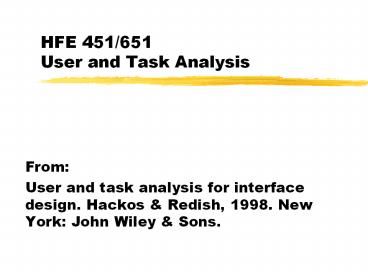HFE 451651 User and Task Analysis PowerPoint PPT Presentation
1 / 18
Title: HFE 451651 User and Task Analysis
1
HFE 451/651User and Task Analysis
- From
- User and task analysis for interface design.
Hackos Redish, 1998. New York John Wiley
Sons.
2
Topics
- Needs Analysis
- User Analysis
- Task Analysis
- Conceptual Evaluation Plan
3
Needs Analysis
- Establish that a system (or product) is needed
based on goals of organization and/or
marketplace. - Basic goals
- Purpose
- features
- Specify what will be required in the system and
what would be nice to have.
4
User Analysis
- Understanding the users
- (examples)
- Who are the users?
- What do the users want?
- What are the users goals?
- What are individual characteristics that may
affect behavior with software or information
designed? - What do they know that helps them perform their
tasks? - What values to they bring to their job?
- Do they want a user interface that is fun, not
boring?
5
Understanding the users (cont.)
- Are they interested in saving money, saving time,
becoming an expert, having an easy job to do? - What is their prior experience with similar tools
and interfaces? - What jobs or tasks will the be performing? Under
what conditions?
6
User Analysis
- Users you may want to study include
- users who buy and use the software alone (e.g. at
home) - users who use it as part of the work they do
- groups of people who use software as part of a
larger business process - software administrators
- users who repair or troubleshoot
- users who install
- customers of the users
7
User Analysis
- Some examples of data to collect
- Age, gender, physical differences,
- experience in job, educational level, background
of training - geographic location, wage differences, culture
and nationalities - language skills, terminology differences
- job level (eg. technicians vs engineers, or
technicians vs doctors) - Assumptions about the users (how to test these
assumptions) - Mental models users have
- Individual differences
- Motivational differences
8
Task Analysis
- Complete description of tasks, subtasks, and
methods for performing task. - Analysis of users tasks - what they do and what
they need to do. - Function analysis - determining what functions
the system as a whole (computer and user) will
include - Task-Function allocation - What will be allocated
to the various components of the system (e.g.
what will the user do, what will the system do) - Requirements Analysis - What will be the
requirements for the design.
9
Task Analysis
- User Goals
- Relating Goals to tasks and actions
- Choices of task to meet goals
- What users do when they encounter problems
10
Types of Task Analyses
- Work Flow Analysis
- What is the process by which they accomplish the
work. - This includes work that flows across people.
- Where are communication links?
11
Types of Task Analyses
- Job Analysis
- Understanding what a person does in their
particular job. What tasks do they perform? - Frequency How often do they perform the tasks?
- Criticality How important are the tasks?
- Time How time consuming are the tasks?
- Difficulty How difficult are the tasks?
- Division of responsibility Do all people in the
job perform this task?
12
Techniques for Task Analysis
- Task Lists or Inventory
- Good for pre-design.
- What tasks do the user want to accomplish using
the product? (Does not tell you how!) - Example Email Program
- write message
- send message
- receive message
- read message
- save message
- etc..
13
Techniques for Task Analysis
- Process analysis or task sequences
- Series of tasks that users are likely to do (or
must do) in a certain order - E.g. write a mail message precedes sending it.
- Example, operational sequence diagram
14
Techniques for Task Analysis
- Task hierarchies
- Task can be decomposed into their sub-tasks
15
Techniques for Task Analysis
- Procedural analysis
- Determine what a user does in performing a
specific task. What decisions and actions must be
made? - Shows how users are currently using tools.
16
Consider stages of users
- Novices
- Novices are goal and task oriented
- Novices do no want to learn, just do
- Advanced Beginners
- Focus on accomplishing task
- Impatient with learning concepts rather than
performing tasks - Randomly access tasks
- By adding new and more complex tasks begin to
develop empirically based mental model
17
Consider stages of users
- Competent performers
- Focus on accomplishing more complex tasks that
require many coordinated actions - Ability to plan how to perform a complex series
of tasks to achieve a goal - Willingness to learn how the task fits into a
consistent mental model of the interface as a
whole - Interest in solving simple problems by applying a
conceptual framework to diagnose and correct
errors
18
Consider stages of users
- Experts
- Focus on developing a comprehensive and
consistent mental model of the product - Ability to understand complex problems and find
solutions - Interest in learning about concepts and theories
behind a product - Interest in interacting with other experts

